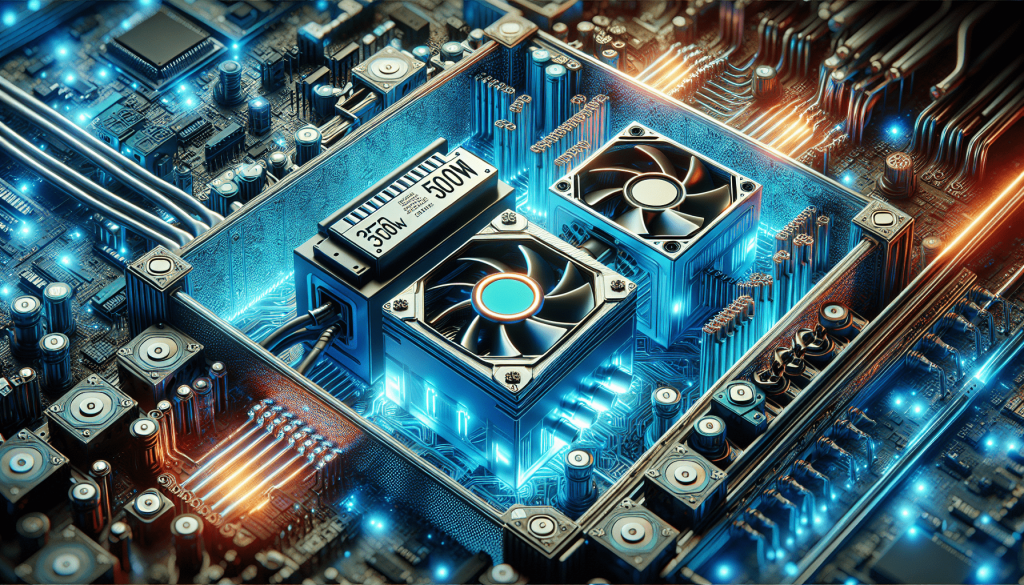Is 350W Better Than 500W?
Are you confused about whether a 350W power supply is better than a 500W power supply? Understanding the difference in wattage can be quite puzzling, especially when it comes to choosing the right power supply for your electronic devices. In this article, we will explore the pros and cons of these two wattage options, helping you make an informed decision for your power needs. So, let’s dive in and unravel the mystery behind which wattage reigns supreme!

Power Output
Definition of Power Output
Power output refers to the amount of electrical power that a device or system can provide or deliver. It is measured in watts (W), which represents the rate at which energy is consumed or produced. Power output is an essential specification to consider when selecting electronic devices, as it determines their capability to perform certain tasks and meet power demands.
Importance of Power Output in Electronic Devices
The power output of electronic devices is crucial because it directly impacts their performance and functionality. Insufficient power output can lead to inadequate operation, reduced efficiency, and even system failures. On the other hand, an appropriate power output ensures that the device receives the necessary electrical energy to perform optimally.
Comparison of 350W and 500W Power Output
When comparing power outputs, it is important to consider the specific requirements of your electronic devices. Both 350W and 500W power outputs have their advantages and disadvantages. Let’s take a closer look at how they stack up against each other:
Device Compatibility
Considerations for Device Compatibility
When choosing a power supply, compatibility with your devices is crucial. Factors such as voltage compatibility, connectors, and wattage requirements need to be considered. Ensuring that your power supply matches the needs of your devices is essential to guarantee proper functioning and prevent any potential damage.
Advantages and Disadvantages of Using 350W Power Supply
A 350W power supply can be sufficient for many low to mid-range electronic devices. It offers the advantage of being more cost-effective, as it consumes less energy and is generally less expensive. However, its lower power output may limit compatibility with power-hungry devices or systems that require more energy.
Advantages and Disadvantages of Using 500W Power Supply
A 500W power supply, on the other hand, offers higher power output and compatibility with a wider range of devices. It provides better stability and flexibility, making it suitable for powering high-performance components or devices with greater energy demands. However, it comes at a slightly higher cost and may be less energy-efficient compared to a 350W power supply.
Energy Efficiency
Understanding Energy Efficiency Ratings
Energy efficiency ratings indicate how effectively a power supply converts input electricity into the usable output power. This is represented as a percentage, with higher values indicating greater efficiency. Energy-efficient power supplies not only save electricity but also produce less heat and contribute to a more sustainable environment.
Comparison of Energy Efficiency between 350W and 500W Power Supplies
While both 350W and 500W power supplies can vary in terms of energy efficiency, it is important to note that higher power outputs usually result in slightly lower energy efficiency. This is because larger power supplies may have more internal components and higher idle power consumption. However, the difference in energy efficiency between the two is generally negligible and may not significantly impact electricity costs.
Impact of Energy Efficiency on Power Consumption and Electricity Costs
Choosing a more energy-efficient power supply can lead to long-term cost savings by reducing power consumption. While the initial cost of an energy-efficient power supply may be slightly higher, the lower energy bills over time can offset this expense. Additionally, it contributes to a greener environment by reducing overall electricity usage.
System Requirements
Factors to Consider for System Requirements
When evaluating power supply options, it is crucial to consider the requirements of your entire system or setup. Take into account the power demands of individual components, including the motherboard, processor, graphics card, storage devices, and other peripherals. Properly calculating power requirements will ensure system stability and prevent potential issues.
Compatibility with High-Performance Components
High-performance components, such as advanced graphics cards, processors, and multiple storage drives, may require a higher power supply. These components demand additional electrical power to operate at their full potential and deliver optimal performance. A 500W power supply provides the headroom necessary to support such power-hungry components without straining the system.
Compatibility with Power-Hungry Devices
Certain devices, like gaming consoles, high-end graphics cards, or large-scale servers, are known for their substantial power consumption. These power-hungry devices often require a power supply with a higher output to ensure stable operation and prevent potential damage. Therefore, a 500W power supply may be a more suitable choice for these devices than a 350W power supply.

Overclocking Potential
Definition and Benefits of Overclocking
Overclocking involves modifying the clock frequency and voltage of components to achieve higher performance levels than their factory settings. It can provide significant performance gains in tasks that heavily rely on CPU or GPU performance, such as gaming or content creation. Overclocking can unleash the full potential of your system, but it also requires additional power.
Effect of Power Output on Overclocking Potential
Overclocking increases the power demands of a system, especially on the CPU and GPU. A higher power output, like that provided by a 500W power supply, can ensure the stability and reliability required for successful overclocking. It allows the components to consume the additional power without straining the power supply, which can result in system instability or even failure.
Comparison of 350W and 500W Power Output in Overclocking Scenarios
While a 350W power supply may be suitable for moderate overclocking, a 500W power supply provides more headroom and stability for more aggressive overclocking. Additionally, with future upgrades and component advancements, the higher power output of a 500W power supply offers more flexibility for potential increases in power demands.
Stability and Reliability
Factors Affecting Stability and Reliability
Stability and reliability are crucial aspects of any electronic device or system. A stable and reliable power supply ensures consistent and uninterrupted power delivery, which in turn protects sensitive components from voltage fluctuations or power surges. Factors such as build quality, component selection, and load capacity play a significant role in determining stability and reliability.
Impact of Power Output on Stability and Reliability
Insufficient power output can strain a power supply, leading to decreased stability and reliability. Underpowered systems are prone to voltage dips, causing crashes, system freezes, or even damage to critical components. A 500W power supply offers a higher output capacity, ensuring stable power delivery and minimizing the risk of system instability or failures.
Comparison of Stability and Reliability for 350W and 500W Power Supplies
While a 350W power supply can provide stable operation for low-power systems, a 500W power supply offers an extra level of stability and reliability. The higher power output and increased headroom provide a cushion against power spikes or fluctuations, making it a more suitable choice for demanding applications, gaming, or systems with power-hungry components.

Noise and Cooling
Noise Levels and Cooling Requirements for Different Power Outputs
Power supplies generate heat during operation, and the cooling mechanisms play a crucial role in maintaining optimal temperatures. Higher power outputs usually result in increased heat dissipation and may require more robust cooling solutions. The cooling fans within power supplies can also contribute to noise levels, especially when running at higher speeds to dissipate excess heat.
Comparison of Noise Levels and Cooling Performance for 350W and 500W Power Supplies
In terms of noise levels and cooling performance, both 350W and 500W power supplies can vary depending on their design and manufacturer. However, in general, a higher-output power supply like the 500W option may have larger cooling fans or more advanced cooling systems to handle the additional heat generated. This can result in lower noise levels and more efficient cooling compared to lower-output power supplies.
Benefits of Efficient Cooling in High-Power Systems
Efficient cooling is essential for maintaining the stability and prolonging the lifespan of electronic components. By effectively dissipating heat, efficient cooling prevents components from overheating and potentially malfunctioning. High-power systems, especially those with power-hungry components or running resource-intensive tasks, greatly benefit from robust cooling solutions provided by higher-output power supplies.
Upgradability and Future Proofing
Considerations for Upgradability and Future Proofing
When investing in a power supply, it is wise to consider future upgradability and compatibility with evolving technologies. A power supply with a higher output provides more headroom for future upgrades, allowing for seamless integration of new components or technologies without the need for a power supply upgrade.
Advantages and Disadvantages of Higher Power Output for Upgradability
A higher power output, such as that provided by a 500W power supply, offers advantages in terms of upgradability. It can accommodate power-hungry components or systems with higher energy demands, making it suitable for future upgrades. However, it is important to consider whether the additional power output is necessary for your specific needs, as a higher-output power supply may be costlier and less energy-efficient.
Impact of Power Output on Compatibility with Future Technologies
As technology advances, newer components and devices tend to have higher power requirements. By opting for a power supply with a higher output, you ensure compatibility with future technologies without the need for frequent power supply upgrades. This future-proofing approach can save both time and money in the long run, as it allows for seamless integration of new components or devices.

Budget and Cost Considerations
Relative Cost Differences between 350W and 500W Power Supplies
When comparing the cost of power supplies, the price difference between a 350W and a 500W power supply is generally not substantial. While the exact prices can vary depending on the manufacturer and features, the slight increase in price for a 500W power supply is often justified by its higher power output and compatibility with a wider range of devices.
Cost-Effectiveness Evaluation based on Performance and Power Requirements
The cost-effectiveness of a power supply depends on the specific performance and power requirements of your system. If your devices or components do not demand a higher power output, choosing a 350W power supply could be the more cost-effective option. However, if you have power-hungry devices or anticipate future upgrades, a 500W power supply offers better value in terms of performance and future compatibility.
Long-Term Cost Analysis considering Energy Efficiency
Energy efficiency ratings also play a role in long-term cost analysis. While higher-output power supplies may have lower energy efficiency compared to their lower-output counterparts, the impact on overall electricity costs is often negligible. Additionally, the potential cost savings resulting from reduced power consumption with a more energy-efficient power supply can offset the slightly higher initial cost.
Final Verdict
Evaluation of Different Factors for Making a Decision
When deciding between a 350W and a 500W power supply, it is essential to evaluate various factors. Consider your specific device compatibility, power requirements, system stability, potential for upgrades, and budgetary constraints. By carefully assessing these factors, you can make an informed decision that meets your needs and ensures optimal performance.
Recommendations Based on Specific Use Cases and Requirements
For low to mid-range electronic devices with moderate power demands, a 350W power supply can be a suitable and cost-effective choice. On the other hand, if you have power-hungry devices, plan for potential upgrades, or require stable operation in demanding scenarios like gaming or content creation, a 500W power supply offers more headroom, stability, and future compatibility.
Consideration of Personal Preferences and Priorities
Personal preferences and priorities also influence the decision-making process. Some individuals may prioritize energy efficiency and sustainability, while others may prioritize performance or upgradability. It is important to weigh these personal factors alongside the technical considerations to select a power supply that aligns with your individual needs and aspirations for your electronic devices or systems.
In conclusion, there is no definitive answer to whether 350W is better than 500W. It all depends on your specific requirements, system compatibility, and future plans. By considering factors such as device compatibility, energy efficiency, stability, cooling, and future upgradability, you can make an informed decision that suits your needs while optimizing the performance and longevity of your electronic devices or systems.








